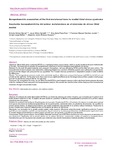Asociación baropodométrica del primer metatarsiano en el síndrome de stress tibial medial

Ver/Abrir
Use este enlace para citar
http://hdl.handle.net/2183/21926Colecciones
Metadatos
Mostrar el registro completo del ítemTítulo
Asociación baropodométrica del primer metatarsiano en el síndrome de stress tibial medialTítulo(s) alternativo(s)
Baropodometric association of the first metatarsal bone in medial tibial stress syndromeAutor(es)
Fecha
2018Cita bibliográfica
European Journal of Podiatry, 2018, 4 (1): 1-9 ISSN: 2445-1835
Resumen
[Resumen] Objetivos: El síndrome de estrés tibial medial (SETM) es una lesión de sobreuso por estrés mecánico, que se localiza por lo general en el borde postero-medial de la tibia. El objetivo de este estudio es cuantificar la diferencia baropodométrica existente en la primera cabeza metatarsal entre dos grupos.
Métodos: Se analizaron las huellas de 30 participantes, de los cuales 15 padecían SETM y 15 controles. Se trata de un estudio observacional en el que se obtuvieron las huellas baropodométricas de los participantes, caminando sobre una plataforma de presiones. Se cuantificó la presión plantar media y la integral presión/tiempo que estaba recibiendo cada paciente en la primera cabeza metatarsal. Realizamos la prueba t-student para muestras independientes con el objetivo de definir las diferencias.
Resultados: Los resultados de la variable presión plantar media muestran diferencias estadísticamente significativas entre los 2 grupos (p=0,001 para pie izquierdo y p=0,001 para pie derecho). Por el contrario no se observaron diferencias estadísticamente significativas para la variable integral presión/tiempo en ambos grupos (p=0,327 para pie izquierdo y p=0,300 para pie derecho).
Conclusiones: Según nuestro estudio, los resultados obtenidos concluyen que el SETM se ocasiona con mayor frecuencia en personas con una disminución significativa de la presión plantar en la cabeza del primer metatarsiano medida en plataforma baropodométrica. Consideramos que son necesarios más estudios que evidencien esta relación biomecánica mediante plantillas instrument [Abstract] Objectives: Medial tibial stress syndrome (MTSS) is a mechanical stress overuse lesion, which is usually located at the post-medial border of the tibia. This study aims to quantify the baropodometric difference in the first metatarsal head between two groups.
Methods: For the study 30 patient footprints were analyzed. Among them, half were affected by MTSS and the other half were controls. The baropodometric footprint samples were obtained by walking barefooted over a platform. While the patients were walking the average plantar pressure and the integral ratio pressure/time was quantified. The T-student test was performed in independent samples in order to define the differences.
Results: The average plantar pressure results show statistically significant differences amongst the 2 groups (p=0.001 for the left foot and p=0.001 for the right foot). On the other hand, there were not any significant differences for the integral pressure/time variable in both groups (p=0.327 for the left foot and p=0.300 for the right foot).
Conclusion: By having done this study, we can affirm that the MTSS is more frequent in persons with a significant plantar pressure decrease in the first metatarsal head measured in the baropodometric platform. We consider the need for further studies that prove this biomechanical connection through instrumented insoles.
Palabras clave
Síndrome de estrés tibial medial
Pie
Tibia
Cinética
Tibial medial stress syndrome
Foot
Shinbone
Kinetics
Pie
Tibia
Cinética
Tibial medial stress syndrome
Foot
Shinbone
Kinetics
Versión del editor
ISSN
2445-1835





